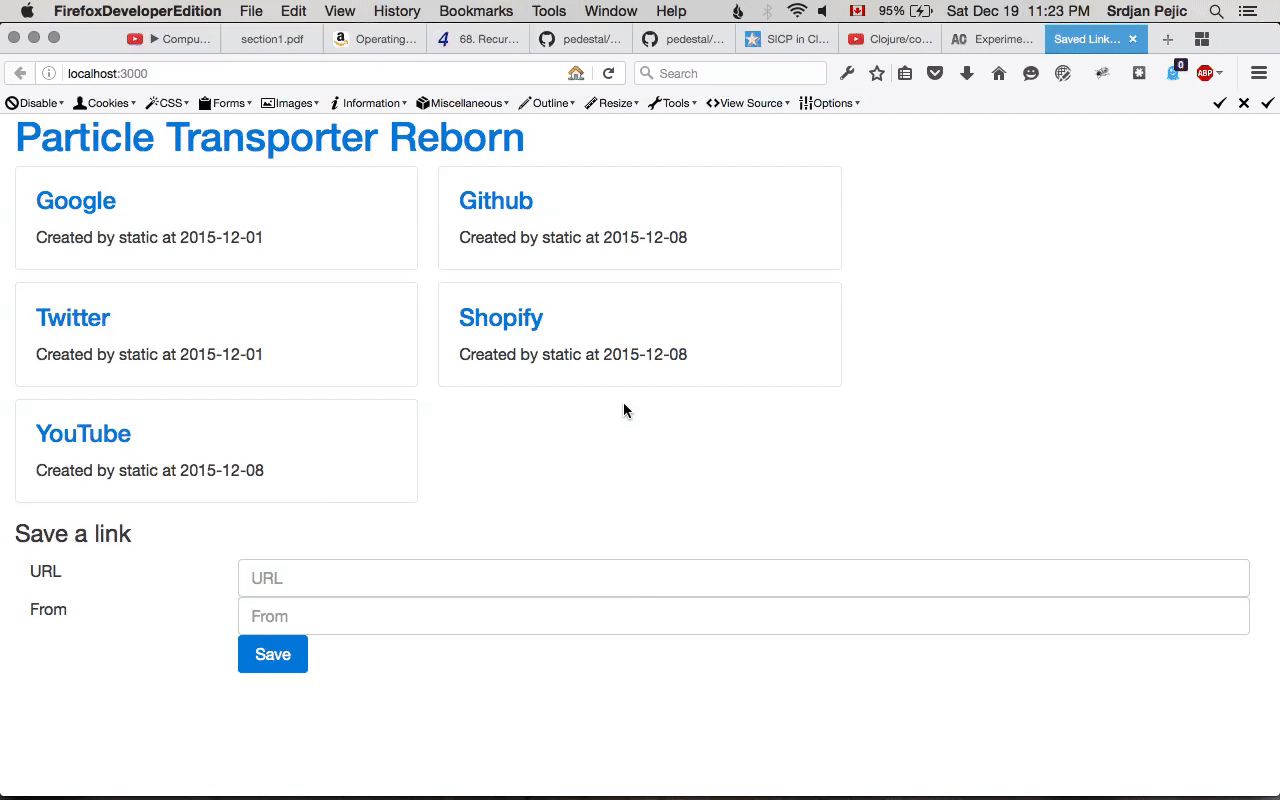POSTS
Experiments part 6
Previously in Experiments, part 5,…
I added a synchronous way of fetching a title from an HTML page, using Enlive.
Let’s async this thing
OK, I want to get the quick response back, but still keep this new functionality. This is where I introduce core.async.
;; in project.clj
[org.clojure/core.async "0.2.374"]
;; in handler.clj's require
(:require [clojure.core.async :as async :refer [>! < ! chan go]])This library is based on concepts presented in a book called Communicating Sequential Processes. The core premise is that certain types of tasks can be handed off to a different process/thread, much like how web developers use background queues to do tasks like sending e-mail, etc. The beautiful thing about Clojure’s implementation is that it’s just a set of macros around core language features. That book is really worth reading. I am saying that more to myself than anyone else reading this.
Using this library, I am going to set up a pipeline that does the synchronous fetch-and-parse in an asynchronous way. For that, I need to set up 2 channels and a few functions that put values and take values from the channel and update things in the background.
(def request-chan (chan))
(def title-chan (chan))
(defn update-title [data record]
(map #(if (= (:id record) (:id %))
(assoc % :title (:title record))
%) data))
(defn update-atom []
(go
(let [record (< ! title-chan)]
(println "Got title" (:title record))
(println "Updating the atom")
(swap! links update-title record))))
(defn async-get-title []
(go
(let [record (< ! request-chan)]
(println "Got the request, processing....")
(>! title-chan (assoc record :title (get-title (:url record)))))))
(defn async-request-title [new-link]
(go
(println "Putting the request on channel")
(>! request-chan new-link)))Reading from the bottom up, the code does the following steps.
- Put the newly created link record to the
request-chanchannel - Take the record off the
request-chanchannel, fetch the title from the HTML page, put the update ontotitle-chanchannel - Take the updated record of
title-chanchannel, update thelinksatom.
Because the update is done in the background, I won’t see the effect until server reload, but that’s fine for now. I have plans for that (did someone say Server-sent Events). Programming can be so much fun, sometimes.
I want to explain the update-title function before moving on, though. Here’s the source for it, again.
(defn update-title [data record]
(map #(if (= (:id record) (:id %))
(assoc % :title (:title record))
%) data))
;; called with
;; (swap! links update-title record)The function loops over the list of links, which are represented as hashmaps. If the id of the current item is equal to the one we want to update, we update the title value. If not, we keep just copy the link map into the new data set. I admit, this is a lot of rigmarole, but again, it’s fun to try not use a database as a crutch. Once I do commit to having a database, this code will likely go away.
Integrating the new way
Now that there’s a way for me to update the atom, I need to integrate that into the flow of a web request.
(GET "/" []
(async-get-title)
(update-atom)
(views/index))
(POST "/api/links" request
(let [next-id (inc (apply max (map #(:id %) @links)))
new-link (:body request)
new-link-with-fields (assoc new-link :id next-id :title (:url new-link) :created_at "2015-12-15")]
(async-request-title new-link-with-fields)
(swap! links conj new-link-with-fields)
(json/write-str @links)))When I load the view, I call the 2 background functions, so that go blocks are set up. The go blocks are where putting and taking from channels are executed. These functions will wait for new input to come in, but since I am not interested in the return value, calling them returns immediately.
The code that creates a link is changed, as well. Firstly, the synchronous fetch is reverted back to what I had initially, where title is the URL. Then, just before adding the new link, a request is submitted for the title attribute of the URL. This kicks off the asynchronous pipeline.
Incoming GIF!
This is how this looks now.

The speed of update is back, since we’re just pre-pending a record to an in-memory data structure. After a reload (or 2), the title is changed, demonstrating the background work.
That’s about it for now. Until the next post.